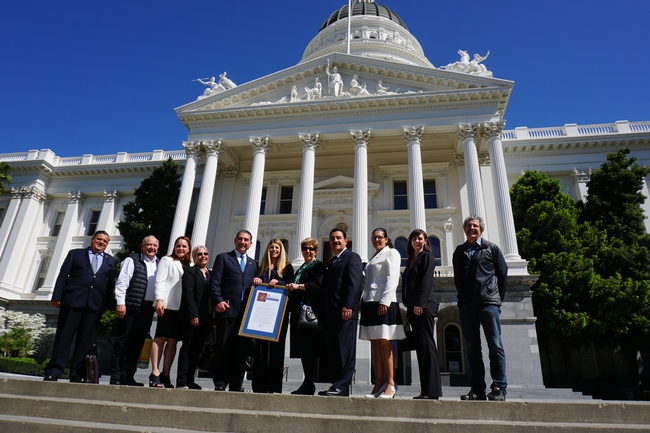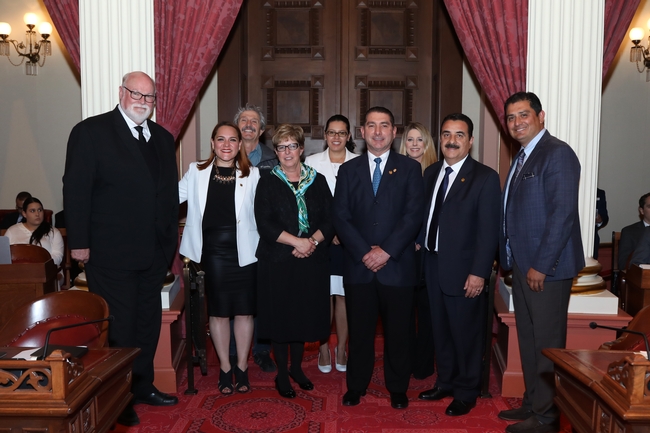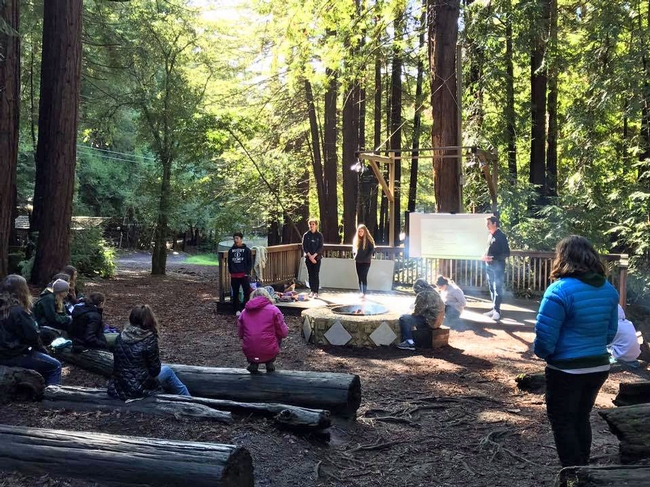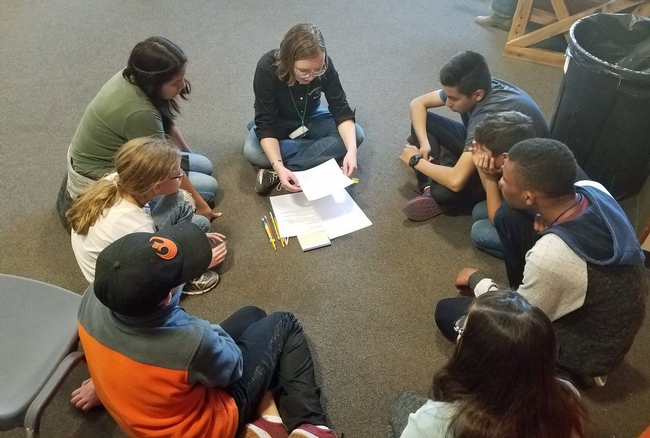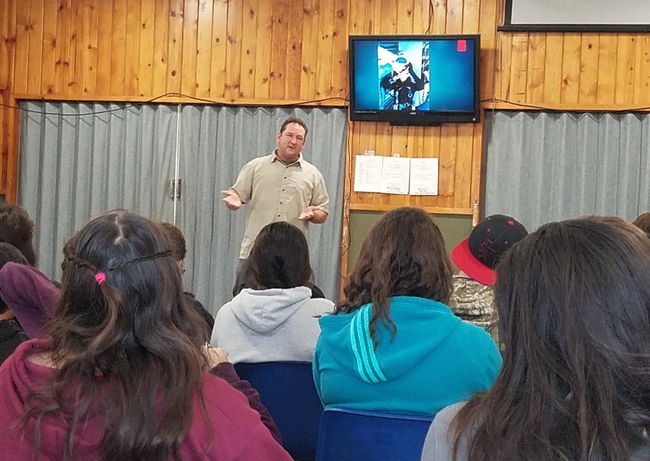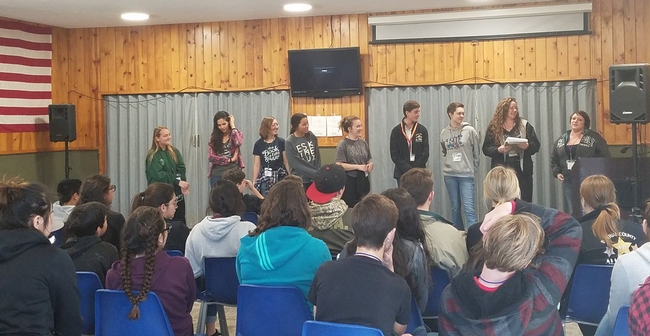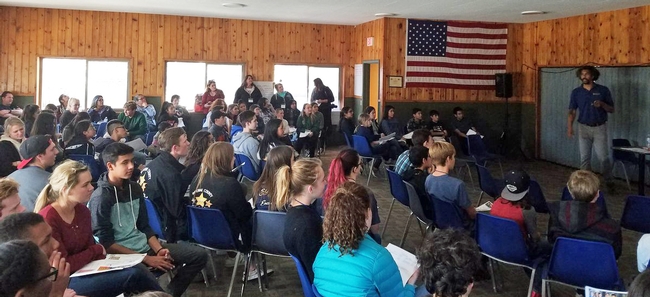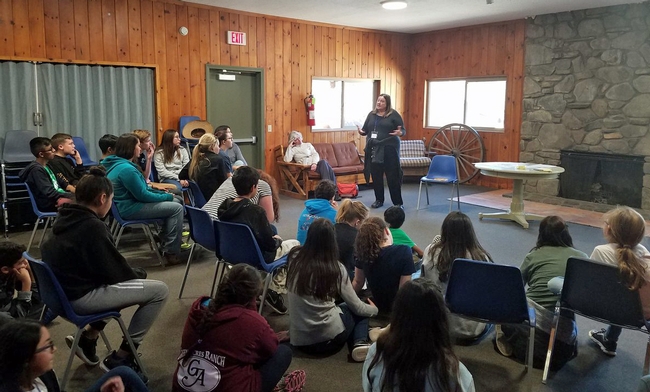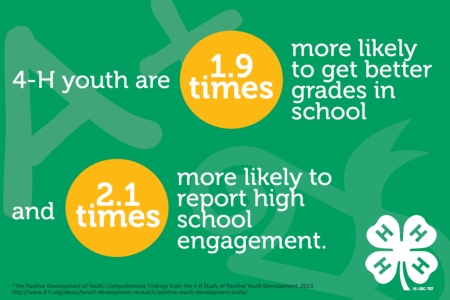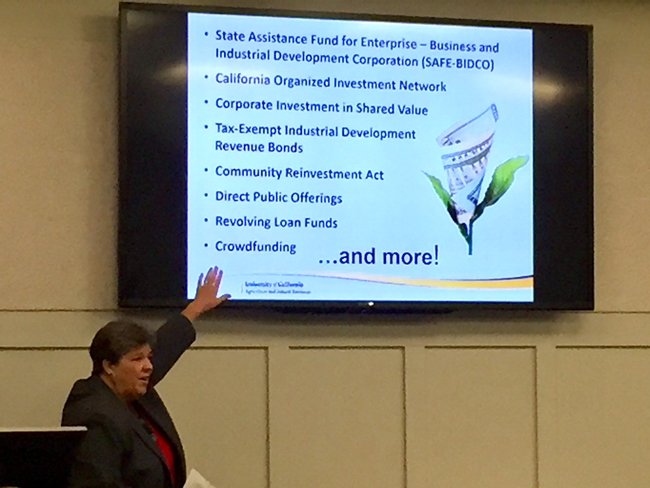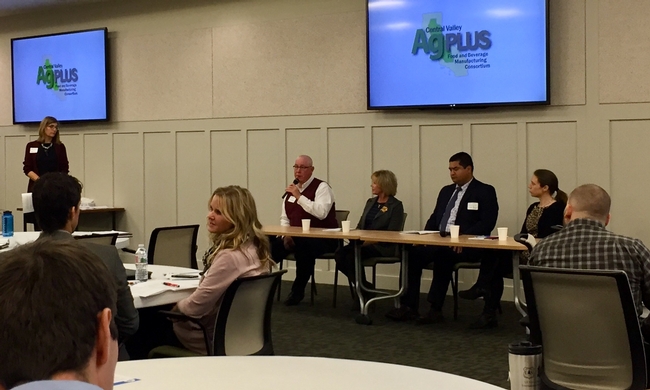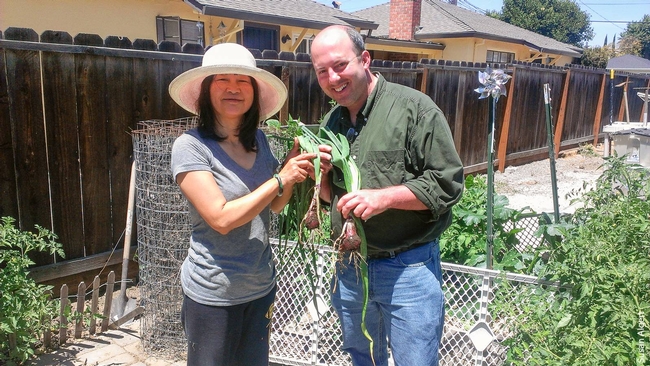- Author: Jeannette E. Warnert
Dignitaries from the Baja California department of agriculture were recognized along with representatives of the UC Agriculture and Natural Resources 4-H program by the California State Senate on April 2 for an agreement the two organizations forged last year to bring 4-H to children across the border.
In presenting a resolution, Senator Ben Hueso, whose district includes the entire 156-mile border of California with Mexico, said the two countries share an agricultural legacy that has faced growing challenges in recent years, such as drought and climate change.
“This requires California and Mexico to share resources by providing access to outstanding educational opportunities what will prepare leaders, scientists, educators, entrepreneurs and professionals with the knowledge and commitment to address these very important issues,” Sen. Hueso said to his colleagues in the State Senate.
Sen. Hueso said education isn't the only issue addressed by the 4-H-Mexico accord.
“This is also a food scarcity issue, addressing food scarcity in our communities and in the world,” he said. “Both Imperial County and Baja California are very big players on the world stage for feeding people.”
The first group of children in the Mexicali 4-H program learned where their food comes from. A second cohort will undertake a project related to science. The program is a model for establishment of similar 4-H experiences for youth in the rest of Baja California and Mexico.
Sen. Hueso introduced the delegation from Mexico, led by Manuel Vallodolid Seamaduras, Secretary of Agriculture Development in the State of Baja California, Mexico (Secretaría de Desarrollo Agropecuario del Estado de México - SEDAGRO), and others in attendance to accept the resolution, including:
- Hortencia Medellin Acosta, Director of Rural Entrepreneurship, Mexicali, Baja California
- Carlos Orozco Riesgo, Member of the UC ANR 4-H Multicultural and Community Engagement Advisory Committee, former Undersecretary of SEDAGRO
- Belem Avendaño Ruiz, Director of Inspection, health and safety SEDAGRO
- Guillermo Gonzalez Rubio, Director, Livestock health department SEDAGRO
- Agustin Manuel Velazquez Bustamante, Legal Advisor SEDAGRO
- Mark Bell, Ph.D., Vice provost, UC Agriculture and Natural Resources
- Shannon Horrillo, Ph.D., 4-H Youth Development statewide director
- Lupita Fabregas, Ph.D., 4-H Youth Development assistant director for diversity and expansion
- Claudia Diaz Carrasco, 4-H Youth Development advisor, Riverside and San Bernardino counties
“I hope that California, the nation's leading agriculture producing state, will continue to foster cooperation with Mexico and train future leaders through the launch of the 4-H Club in Mexicali,” Sen. Hueso said. “Please join me in welcoming them to the California State Senate and thanking them for their work in advocacy in helping educate the future.”
Click here to read the California State Senate resolution recognizing the establishment of a 4-H program in Mexicali, Mex.
- Author: Ricardo Vela
For more than 200 youngsters in California, including 45 Latinos, the last weekend of January was a unique experience, full of physical activities and workshops that will help them build a successful future. Under the theme “Be a leader, Be a hero,” they participated in the 4-H Youth Summit carried out in several California counties. The event showcased the efforts of UC Agriculture and Natural Resources to increase the participation of young Latinos in its 4-H Youth Development Program.
“We are very excited that for the first time 45 Latino youths participated in the Youth Summit,” said Lupita Fabregas, 4-H assistant director for diversity and expansion.
The participating youths, ages 11 to 19, enjoyed hiking and other outdoor activities at the various 4-H camps. Among the camps were Mountain Center, located in the San Jacinto Mountains in Riverside County; YMCA Camp Jones Gulch in La Honda, located in the Santa Cruz mountains in San Mateo County; and Wonder Valley Ranch in Sanger, located in Sierra Nevada Mountains in Fresno County.
The adolescents had the opportunity to learn skills to help them develop their potential in addition to other topics of interest.
“Participants also had the opportunity to learn about engineering design process and the importance of bees to the environment,” said Claudia Diaz-Carrasco, 4-H advisor in San Bernardino and Riverside counties.
The increase of Latino youth in these 4-H camps, is the result of an initiative that has been implemented within the last couple of years.
Seven California counties including Kern, Riverside, Merced, Monterey, Orange, Santa Barbara and Sonoma were selected to participate in a pilot model to increase the number of young Latinos participating in the 4-H program.
The model was designed to ensure that young people living in urban areas could receive the same benefits as those who have participated in 4-H since it was founded in 1902 in Ohio.
“The original goal was that young men and women learned leadership skills through interaction with farm animals and food conservation,” added Fabregas.
For the 21st century, 4-H has designed new methods for young people in rural communities, urban and suburban areas based on the same original principles – offering leadership skills to its participants.
"The 4-H participants learn about issues of global importance such as food security, climate change and sustainable energy. It also teaches them about other issues, such as childhood obesity, and basic finance," said Diaz-Carrasco, who has seen a considerable increase of Latino participants in the 4-H programs in the Inland Empire.
“It was hard, we had many challenges,” said Diaz-Carrasco, who works in a county that is 50 percent urban and its young population is almost 59 percent Latino. Lack of transportation, time and money were the biggest threats to the success of the pilot model.
In 2016, Diaz-Carrasco was selected to participate in UC ANR's Latino initiative, under the direction of Lupita Fabregas. The first step taken was to hire the first bilingual educator of the 4-H program and establish the first bilingual club in a community center in a heavily Latino populated part of the city of Riverside.
"These new models have had an impact on the program in the seven pilot counties," said Fabregas. Two years later, there are three bilingual clubs in the county.
The response from the Latino youth has exceeded expectations. In 2015, the California 4-H program worked with less than 1 percent of children in the state. By 2017, participation in the program grew 16 percent and the participation of Latino children increased 89 percent.
Parents of these young Latinos participating in the 4-H program are seeing positive changes in their kids. According to the parents, 4-H gives their kids an opportunity for social and personal interaction. “It enables young people to understand who they are and prepares them to choose what they are going to do with their life as adults,” said Sergio Sierra, whose children are participating in the 4-H program in Indio, California.
Studies have shown that young people participating in the 4-H program are 1.9 times more likely to get better grades in school and 2.1 times more likely to report being engaged in school activities.
California leads the country with more participants in the 4-H Latino Initiative than other states. In spite of the gains achieved, there is still more outreach to be done, Fabregas said.
- Author: Pamela Kan-Rice
To enhance funding for food and agriculture businesses in the Central Valley, more than 60 people involved in small business finance gathered at the AgPlus Funders Forum Dec. 12 to contribute ideas.
Representatives from financial institutions, economic development organizations, universities, government agencies and innovative funders like community development financial institutions (CDFI) attended. Participants shared innovative financing tools for business and discussed obstacles for people in rural communities to access capital at the forum at the UC Agriculture and Natural Resources building in Davis.
Two primary challenges faced by people trying to start a new business are figuring out how to get started – such as their supply chain – and gaining access to capital to finance their endeavor, according to keynote speaker Glenda Humiston, University of California vice president for agriculture and natural resources.
“There are actually an array of sources of capital beyond just the traditional bank loan, the problem is people don't know about them or how to access them,” Humiston said. She added that much more capital could be available to Central Valley businesses if residents would invest locally. “If you had brought home just one percent of the retirement accounts held by people in the AgPLUS region back in 2010, you would have had over $1 billion to invest in this region,” she said.
Marc Nemanic of 3CORE, Carrie Ellinwood of U.S. Small Business Administration, Ismael Herrero of Fresno State's Office of Community and Economic Development, and Catherine Howard of Northern California Community Loan Fund discussed some of the challenges for financing new businesses and alternatives to traditional bank loans.
Nemanic noted that many millennials are carrying student loan debt, which may make them averse to taking on more debt or prevent them from qualifying for business loans.
Howard said her organization is creating a tool to help people satisfy collateral requirements for credit.
To build their businesses, entrepreneurs often need technical assistance so Herrera's office pairs young companies with experienced mentors and other services. Herrera said he is working to create public and private partnerships in rural communities, such as commercial kitchens for people to turn farm produce into value-added products to sell at farmers markets.
Panelists pointed out that jobs in the gig economy, such as driving for Uber or Lyft, don't provide the stable income that tradition lenders seek in borrowers so they need to create a flexible product.
In the afternoon, participants split into four groups to focus on identifying opportunities for supporting economic development, supporting small business and microenterprises, effective intermediaries to connect investors with entrepreneurs, and regional finance funds. Each topic was discussed by a diverse group of people as peers and experts, bringing their own expertise to the table.
To address the interplay between higher education, student debt and the structural changes in the nation's economy, Meg Arnold, who moderated the session, said she could foresee policy implications.
“Student debt is not forgivable,” said Arnold, managing director of Valley Vision. “At the same time we are making a four-year university degree both more necessary and less affordable, the economy is also changing, to the point that some graduates may need to think of self-employment or gig economy employment.”
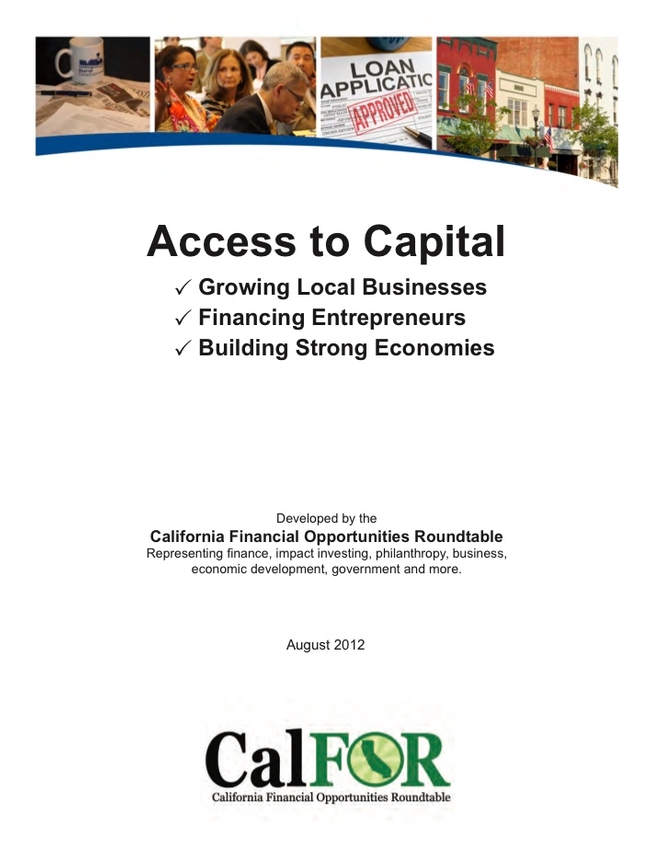
“We need everybody who participated today to share those examples of where something kind of unique or innovative is really working,” said Humiston.
Ideas generated during the forum will be used to inform the work of the Central Valley AgPLUS Food and Beverage Manufacturing Consortium, which hosted the AgPlus Funders Forum. The information will also be used by Humiston to update the 2012 Access to Capital Report by California Financial Opportunities Roundtable (CalFOR). The report highlights financial needs for businesses in California, reviews financial tools and capital sources and provides policy recommendations. Humiston will also convey the outcomes to the California Economic Summit.
The AgPlus Funders Forum was sponsored by Chase Bank, Valley Vision, the Center for Economic Development, First Northern Bank, the Federal Reserve Bank of San Francisco, Employment Training Panel, Blue Tech Valley, Fresno State Community and Economic Development and UC ANR.
- Author: Jeannette E. Warnert
For the 11th year in a row, the most popular item on holiday wish lists is gift cards. According to a 2017 National Retail Federation Survey, 61 percent of respondents wished for gift cards, while 55 percent listed clothing and accessories and 39 percent would like books, music or movies.
“In the past, gift cards may not have seemed like a very thoughtful gesture,” said Patti Wooten Swanson, consumer sciences advisor with UC Cooperative Extension in San Diego County. “But today, it's what people want.”
Wooten Swanson has a Ph.D. in consumer science from Texas Women's University in Denton, Texas. She is the author of a seven-part series of financial caregiving publications and is co-chair of the UC Agriculture and Natural Resources Money Talks workgroup, which created a Money Talks website that helps teens and young adults learn to manage their finances.
Gift cards are subject to several consumer protection laws. The federal government mandates that retail gift cards (for a specific merchant or company) and bank-issued gift cards are valid for five years from date of purchase. In California, state law stipulates that most gift cards cannot expire or charge a service fee.
A survey by Consumer Reports found that 10 percent of gift card value typically goes unused. The magazine suggests cash or a check are great alternatives, but Wooten Swanson says she still sometimes opts for gift cards.
“Cash can tend to be used for everyday things,” Wooten Swanson said. “If I want my dad to enjoy a meal at his favorite restaurant, I would give a gift card for the specific restaurant.”
Wooten Swanson offers the following suggestions for ensuring successful gift card experiences:
- If you receive a gift card, use it as quickly as possible. If the retailer goes out of business, the card will have no value. “Also, it's easy to misplace or forget about the card,” Wooten Swanson said.
- Consumers' first choice when selecting gift cards should be those offered by specific retail stores (and their affiliates) or restaurants, Wooten Swanson recommends. “Generally, there are no fees for purchasing them either at the retail outlet, online or at a gift card kiosk in the grocery store,” she said. “The card is valid for at least five years and, by law, no inactivity fees can be charged during the first 12 months.”
- Before buying the gift card, Wooten Swanson suggests looking carefully at the back to be sure that the hidden card number that is usually underneath scratch-off ink has not been exposed. “To steal the value on cards, thieves can copy down the hidden code number at the store. After the card is purchased and funded, the thief can use the code for online purchases, making the card worthless for the person who receives the gift,” she said.
- Always include the store receipt in the gift along with the card. If the gift card is lost or stolen, the recipient can call the company to see if it can be replaced.
- Only purchase gift cards from sources you know are reputable. Some websites allow consumers to buy gift cards at a discount and sell unwanted gift cards at an amount below the face value. “You want to be dealing with a known company to be sure you're getting the real thing,” Wooten Swanson said. She recommends consumers interested in discounted gift cards instead visit big box retailers like Costco or Sams Club, where packets of gift cards are available at a discount.
- Carefully read the conditions attached to bank or credit card company gift cards. They can be used almost anywhere the recipient would like to spend the funds, but most charge a fee to purchase the card and, after 12 months of inactivity, can charge a monthly fee by reducing the balance on the card. “This year many restaurants and retailers are reward those who buy the card with a BOGO bonus. The bonus gift cards obtained often do have an expiration date,” Wooten Swanson said. “Some may not be redeemable immediately.”
- Author: Pamela Kan-Rice
Aspiring farmers are invited to apply for Urban Edge Sustainable Farming, a program that will expand the range of opportunities for beginning farmers in California by leveraging 550 acres of prime, protected East Bay farmland for training, farm business incubation and long-term leasing.
As baby boomer farmers retire, a new generation of farmers is needed to carry on the work.
“Small and mid-size farmers are vital to the strength of our local communities and the security of our food supply,” said Alli Cecchini, First Generation Farmers executive director. “If there are no farmers to keep fertile land in production, it will be sold to developers and we'll never get it back.”
First Generation Farmers received a grant from the USDA National Institute of Food and Agriculture Beginning Farmer and Rancher Development Program to launch Urban Edge Sustainable Farming as a formal training and incubator program that combines classroom-style instruction with hands-on field training. The program is designed to provide beginning specialty crop farmers with the core agricultural production skills, business knowledge and the confidence they need to establish viable farm businesses.
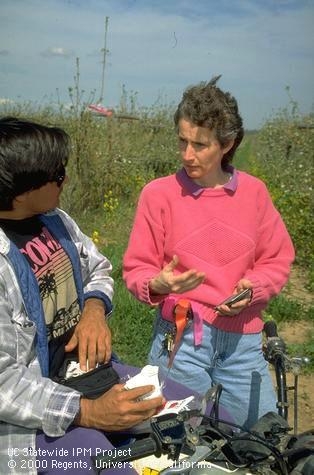
“It's a very nice mix of practical application and applied science,” said Janet Caprile, who recently retired after 30-plus years as a UC Cooperative Extension farm advisor. “It's very hands-on approach to education – more like an apprenticeship program. I've signed on to present.”
Urban Edge Sustainable Farming is a full-time, nine-month residency. In 2018, the course will run from Feb. 5 through Nov. 5, with a one-week break in early July. Beginning farmers will live on site in dorm-style housing for an immersive, cooperative learning experience. The curriculum is designed and delivered by First Generation Farmers and professional instructors from the National Center for Appropriate Technology and UC Cooperative Extension. Participants will also learn from working alongside the Cecchini family — successful, fourth-generation farmers who are bridging agricultural tradition with adaptation to 21st century practices and market demands.
The training covers a wide range of topics, including composting, organic practices, greenhouse management, pest and disease management, healthy soil management, cover crops and crop rotation, biodynamic farming, crop planning, food safety and handling, marketing strategies, financial record-keeping and business planning. First Generation Farmers will introduce participants to regional direct and wholesale markets.
“What UESF [Urban Edge Sustainable Farming] offers beginning farmers is unique in California: an opportunity to farm on historic farmland, in close connection with a traditional farm family, in a changing farming community on the edge of a major and expanding urban market,” said Poppy Davis, independent ag business and policy consultant and research professor at the University of Arkansas School of Law.
Urban Edge Sustainable Farming is open to all applicants, but the program prioritizes admission for beginning farmers with limited resources, military veterans, and those from socially disadvantaged backgrounds, including women, members of the LGBTQ community, people of color, immigrants and refugees. Because a diverse population of farmers makes for a stronger and more resilient farming community, the program aims to support farmers who often experience significant systemic barriers to starting their enterprise.
Up to 15 beginning farmers can be accommodated in the first cohort and applications will be accepted until the cohort is full. Applicants must be 18 years old and previous farm experience is not required. Tuition for the program is $4,000 and includes food and lodging. For more information and to apply, visit https://firstgenerationfarmers.org/uesf.

